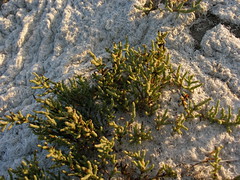While I was trolling the aisles of Whole Foods the other day, I stumbled upon a familiar salt marsh plant known as glasswort (Salicornia virginica). When I would lead early morning nature walks along the beaches in Florida this marsh herb was a plant I enjoyed finding! Here’s the interesting anecdote I’d share with my sunrise hikers.
Glasswort, also known as poorman’s asparagus or marsh samphire, can be eaten boiled or pickled in vinegar. Early settlers in Florida cooked and pickled glasswort because of its high salt content. The salty stems are the edible part of this plant.
For centuries, glassworts was collected and burned to create an ash rich in soda (impure sodium carbonate). The ash was then baked and fused with sand to make crude glass, consequently, provided reason for the glassworts main common name.
Another reason this plant got its most popular common name, glasswort, is that when someone steps on a bed of this plant, it sounds like they’re walking on broken glass.
Glasswort is common along beach dunes and salt march flats on the east and west coasts of the U.S. It is easily recognizable with its cactuslike bright green stem, tiny red flowers, scale-like leaves. It is particularly well suited to live along the coast because it has a thick waxy skin that protects itself from the salt water spray. Another glasswort adaptation to help in this rather harsh climate is the addition of vacuoles within their root cells that lock up to prevent salt from being absorbed through its roots. Glasswort is usually only 4-12 inches long and has a horizontal main stem with lateral branches. Be careful you don’t trip on this matted down plant!
![]()











What people are saying …